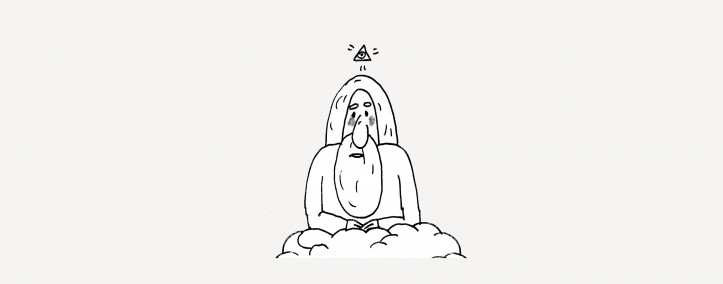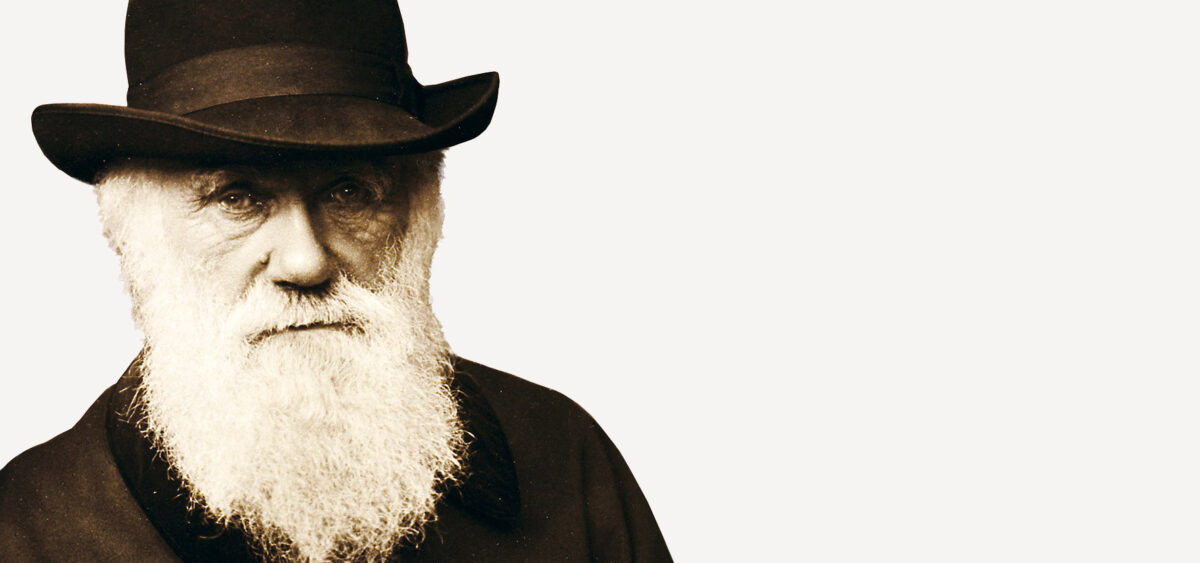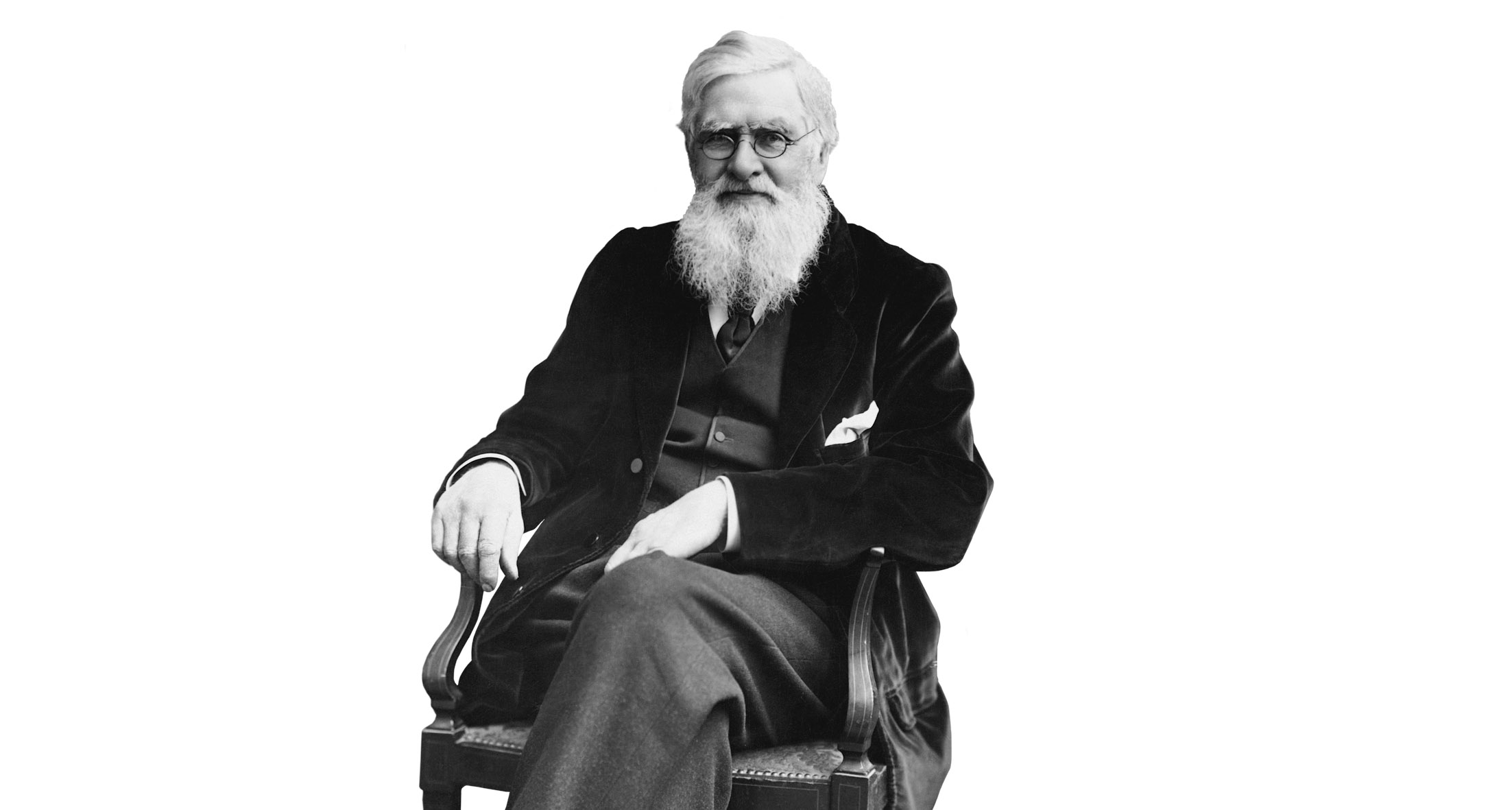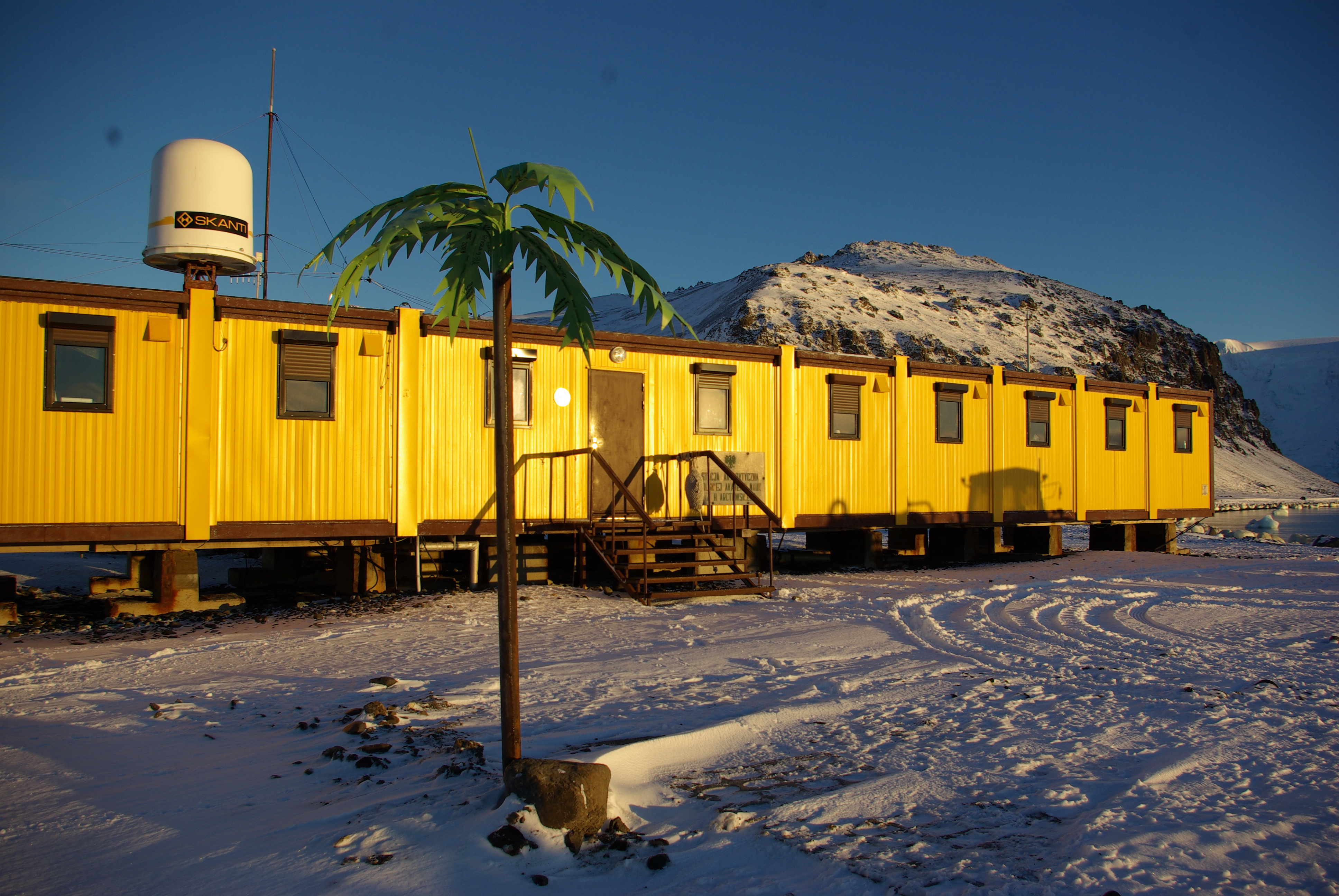
In order to try to briefly describe the story of Charles Darwin and his revolutionary theory we could use five words: chance, restraint, ingenuity, practicality and diligence . . .
When HMS Beagle finally left the British port of Plymouth on December 27, 1831, no one had any idea that the fate of humanity had taken a turn, and that our species would soon embark on the most fascinating, instructivem and consequential journey in its intellectual history.
A Chance Trip in Spite of His Nose
Charles Robert Darwin was certainly not thinking about that when, thanks to some acquaintances, the young graduate, who was just shy of his 23rd birthday, was hired as a geologist and gentleman on the crew of the Beagle. Captain Robert FitzRoy took him aboard principally in order to have an intelligent person to talk to during the three-year research voyage. They were already one month late in departing, chiefly because of the raging December storms, but also because they had lost at least one day to Christmas drunkenness.
Darwin was unaware that he had very nearly not been selected for the trip. FitzRoy was a great admirer of the then-very fashionable idea of phrenology, which looked for links between the shape and size of the cranium as a supposed indication of character and mental abilities. During their first meeting, FitzRoy wanted to reject him for his “strange nose,” which allegedly indicated no great intellect, nor the required determination. However, during that first discussion, he changed his mind and, on that occasion at least, the pseudo-scientific theory didn’t get in the way of true science. Both earlier and, surprisingly, nearly two hundred years later, this often happened.
Darwin was young and bright with a Cambridge education, and he came from a very good family with a long tradition of intellectual pursuits. His father was a famous doctor and his grandfather, Erasmus, a famous geologist (in addition to his well-deserved infamy as a womanizer and reveller). Against the wishes of his parents, Charles gave up his medical studies, later completing a standard bachelor’s degree (including a course in geology), but rather than studying, he preferred gentlemanly pursuits, such as horse riding, shooting birds and collecting rare beetles. He was always interested in the natural world and read widely on the subject, but, as he himself later claimed, during this time he derived more pleasure from Shakespeare, Milton, and Byron, as well as a number of other poets. However, he was certainly honest, methodical, and inquisitive. On the expedition, he was supposed to concentrate on geology and collect as many specimens as possible, including animals and plants—both the living (at that point anyway) and the long dead (in the form of fossils). I suspect that he treated the expedition as an exciting adventure and a period of time to think about what to do next.
Practical Conclusions from Observing Dogs
HMS Beagle’s voyage was somewhat extended; the planned two-to-three years turned into five. Darwin changed beyond recognition during this time. From an absent-minded student, he became a serious researcher of living nature (or, as it was then described, “natural history”) and geology. When he returned to England, his fame as a specimen collector preceded him, and his disappointed father finally started to be proud of his son. Charles had sailed around the world, and discovered and described a multitude of living and extinct species. The collections of specimens, which he gathered and sent home throughout the expedition, can still be seen today in museums. Obviously, the most famous episode of the whole journey was the visit to the Galapagos Islands. It was here that the young scientist became convinced that the birds living on the different islands of the archipelago, although similar, varied slightly and used their divergently-shaped beaks for different types of food. Today, these birds are called Darwin finches. Likewise, the giant tortoises on each of the islands look slightly different. Could it be possible that these animals came from, respectively, common finch and tortoise ancestors? (The Galapagos for me is a place like Mecca for Muslims. As a naturalist, I simply have to visit them one day).
But for me, the most interesting were his visits to places that I have often been to myself and which I love very much; e.g. to the Falkland Islands, where he spent several weeks (slightly longer than on the Galapagos) at the turn of 1833 and 1834, and to the Beagle Channel, discovered by that same ship during an earlier expedition. On the Falkland Islands, Darwin came across the Falkland Islands wolf (or Warrah), the only land mammal native to the islands. Everything else that lives there either had to fly there or swim, but the wolves probably arrived over a land bridge that used to connect the islands with South America during the last Ice Age. These were not real wolves as we know them; yet, they belonged to the dog family, were roughly the size of medium-sized dogs, and genetic testing shows that their closest relative was the maned wolf native to the South American pampas. They lived stress-free in an environment without natural enemies, hunting seabirds, seal, and sea lion pups. However, when sailors began to reach the islands in the seventeenth century (and, after 1764, the colonists), the wolves fearlessly approached the people, driven by the innate curiosity that drives all predators. The sailors used to amuse themselves by offering them pieces of meat with one hand and then, once they got a little closer, killing them with a knife or club held in the other hand. There is no better illustration of man’s relationship with nature.
Darwin himself reckoned that the species wouldn’t survive for long. He gave them the scientific name Dusicyon australis, or “stupid dog from the south,” in reference to their lack of fear of man. Describing them, he expressed the conviction that “Within a very few years after these islands shall have become regularly settled, in all probability this fox will be classed with the dodo, as an animal which has perished from the face of the earth.” (Journal and Remarks, The Voyage of the Beagle). The last Falkland Island wolf was killed a few decades later in 1876.
Inasmuch as his stay on the Falkland Islands and the results of his deliberations are a testament to his perspicacity, his visit to the Beagle Channel and his comments about the native peoples of Tierra del Fuego paint him in a rather poorer light. For the first time, Darwin came into contact with people outside the sphere of European civilization. Thinking about this, I cannot stop myself from telling my favourite anecdote about Mahatma Gandhi, who was once asked for his opinion on ‘European civilization’. After a moment’s thought he said, “Yes, I think that would be a good idea.” For the representative of a culture that had existed for so many thousands of years, the Europeans with their beliefs must have seemed ridiculous.
Charles Darwin was raised in a society convinced of its superiority over everything else in the world, in particular over “savages.” This is the only excuse I can come up with to try to understand his opinion that the local people were the most miserable creatures that he had ever come across. Darwin was convinced that the indigenous people of the Ona and Yaghan tribes made themselves understood through grunts and barking, which could not possibly be regarded as a human language. It is somewhat reminiscent of the behaviour of our Slavic ancestors, who could make themselves understood to their kinsmen living to the east and south but, when meeting neighbours from the west, called them Niemcy. There is no space here to describe the astonishing culture and knowledge of the Patagonian tribes but, suffice to say, that world linguistics has the Yaghans to thank for a word that is believed to carry more meaning and which is harder to translate than any word in any other language. This word is Mamihlapinatapai, which means “the look exchanged between two people, who both want to do something specific which each of them desires, but which neither is prepared to initiate.”
Unfortunately, the conviction that the indigenous peoples of Patagonia were savages led to their extermination in the nineteenth century, when Spanish settlers exterminated those tribes for being “pests” that were disrupting the development of the Spanish cattle ranches and sheep farms. We all know about the genocide of the native tribes of North America, but not everyone realizes that, in Argentina for example, it was at least as bad, if not worse.
Assiduous Observations on the Fight for Survival
The Beagle expedition was the only one Darwin went on. He spent the rest of his life analyzing his discoveries and formulating their interpretations. The account of this trip is a very interesting record of adventures on a ship, but the real adventure was only just getting going. I like to imagine what was going on in the head of the “creator of the theory of evolution.” One can learn a lot from his journals. Charles Darwin saw extraordinary examples of biodiversity on the islands and collected many specimens of animals that no longer existed, but which he accurately described as species related to contemporary ones, such as the giant ground sloth. However, his predecessors had already written about species changes, including his own grandfather and Jean-Baptiste de Lamarck, the French naturalist who published his Zoological Philosophy in 1809. Even earlier, in the fourteenth century, the Arab scholar Ibn Khaldun described a progression in the world of nature, claiming that minerals pass gradually into plants and these, in turn, pass into animals. Medieval Arab scholars were generally much more knowledgeable about nature than their European counterparts.
Back in the ninth century, Al-Jahiz, in his Book of the Animals, contemplated the adaptation of animals and the competition between them, although citing him as a precursor to the theory of evolution would be going too far because he was talking more about proving the perfection of a divine Creator through showing the perfection of his works. But the threads that Darwin would eventually combine into a coherent whole had been around in science for a long time. Still, no one was able to propose a sensible mechanism for how these changes occurred. Lamarck thought that it was the personal experience of each animal, including humans, that caused organisms to change from one generation to the next. That is why, for example, a carpenter who has tough skin on his hands through hard work will have children who are born with tougher skin on their hands than other babies. The best-known example of evolution, according to Lamarck, is the giraffe, who works very hard to reach higher and higher leaves on the trees, leading to giraffe necks lengthening in every generation. Darwin wasn’t convinced by this, although today we know that, in truth, at least on the cellular level, some characteristics adopted in life can be passed onto future generations.

Inspiration also came from other fields of science. In 1797, Thomas Malthus published his economic ideas about how people compete for limited resources and how, although our rate of reproduction should cause very fast population growth, many people will die precisely because of the scarcity of those resources. Beetles lay so many eggs that if something didn’t limit their numbers, within a few years we would all be paddling in a thick layer of these creatures. And yet it is not like that. Many more individuals are born than can survive and, in the competition for resources, some do better than others. The result is that those who manage better can have more children, whose own chances of survival will be greater.
At that time, the mechanisms of inheritance were still unknown, but it was obvious that children were more similar to their parents than to strangers. Furthermore, this was not just the case with people. Darwin was interested in animal husbandry and could see that careful crossing of individual cows or dogs with specific characteristics could shape the next generation. He was particularly fascinated by different breeds of pigeons and in his later years he worked with pigeon breeders, showing how, within a few generations, one could produce individuals with a larger collar around the neck or with more feathery legs. Admittedly, the selection of individuals for crossing was artificial and led to the characteristics desired by the breeders. But perhaps similar selection mechanisms take place in nature, and the characteristics that somehow select themselves and become a permanent feature of future generations are in fact those that condition living things for better adaptation, better competitiveness, or better chances in the fight for survival?
A Restrained Journey Toward Atheism
Darwin came to the conclusion that variation in nature can best and most simply be explained by a process called “natural selection,” a term which, importantly, doesn’t have the connotation of a conscious choice of characteristics. This great naturalist gradually came to understand that for such variety of forms to appear, one just needed a simple algorithm based on a few obvious premises. First, it so happens that different individuals of the same species differ slightly from each other; within a given population, there is natural variation. Second, as a result of these variations, some individuals manage to compete better and leave more offspring than others, and their offspring will inherit the characteristics that determined this; we are talking about heredity. Darwin’s conclusions therefore included elements both of ecology (the science of the connections between different organisms and their environment, which also includes other organisms), and genetics (the science of heredity), although neither of these sciences yet existed. An algorithm like this can have no other outcome; it must lead to change in the organisms and an increase in biological diversity. It is inevitable that, in subsequent generations, the given characteristics will become more widespread until, finally, the changes are present across the entire species. Most importantly of all, this does not require the supervision of any Creator. And it was precisely this realization that troubled Darwin. The official belief prevailing then—and, unfortunately and bizarrely, still clinging on today—was that an omnipotent god created all species simultaneously in their current forms. For Darwin, it was obvious that this was not true. He could tell this even just from the fossilized organisms that are no longer with us and in whose times our contemporaries did not yet exist.
If no Creator is necessary to produce such different species, maybe there simply is no Creator? Darwin never officially declared himself an atheist. However, throughout his adult life he questioned religious beliefs and saw a contradiction between the idea of a benign Creator and the ubiquitous suffering of people and other animals. Towards the end of his life, he described himself as agnostic. But it was because of these inexorable conclusions that Daniel Dennett, one of our best-known contemporary philosophers, described Darwin’s theory as dangerous. In one of his publications from 1995 entitled Darwin’s Dangerous Idea: Evolution and the Meanings of Life (the best book on evolutionism I have read), he equates it to a universal acid that burns everything. Dennett recalls a memorable scene from the classic sci-fi film Alien. In the scene, the astronauts cut open the skin of a dead Alien and when several drops of its blood fall on the laboratory floor, they burn through it and drop down to the deck below, and then through the next one, and through the next. According to Dennett, if we really understand all the repercussions of Darwinian theory, it will have a profound effect on all levels of our consciousness. Not only are we connected to the entirety of the living world, but we are definitely not its crowning creation. Instead, we are just one of many equal branches. At the same time, we also can’t honestly deny the inference that the amazing and wonderful design of every organism that is adapted for life—from viruses and bacteria to orchids, falcons and cheetahs—may not need any designer at all.
An Ingenious Popperian Approach
Darwin realized that an idea like this could not fail to cause a scandal. That is why, for twenty-three years after his return from the expedition, he painstakingly analyzed and described both his own specimens and those sent to him by other naturalists, all the time formulating his ground-breaking theory. He employed the hypothetico-deductive method, not only describing numerous examples from the natural world, but also applying logical reasoning and presenting hypotheses together with methods of falsifying them. In other words, he used the Popperian approach to the scientific method, although Karl Popper would only formulate this several decades later when he set out the rules for a scientific approach to scientific research.
First, one poses a hypothesis and then tests it. The results of the experiment must be repeatable, so that whoever conducts the experiment in the same way should get similar results. This strengthens the hypothesis. At the same time, ways of verifying the experiment must be found, so that, if the test produces some result that completely contradicts the hypothesis, one must be able to verify the test. That is why I love science so much; it is, in its very essence, modest and humble; in the face of new data it does not hesitate to change the current paradigm. This is exactly where it differs from faith, because if some fact contradicts faith, it’s bad luck for the fact.
In other words, Darwin was also ahead of his time in his methodology by chance setting the direction of evolutionary research for the next century, by presenting his theory at every turn as rigorously as humanly possible, and by showing simultaneously what future research would have to prove in order to undermine his theory, even if such experiments were not possible at the time. Darwin wanted his theory of natural selection to be so precisely documented that, in the light of the knowledge of the day and through the available research methods, it was not possible to find any inaccuracies, while honestly showing ways to verify it.
At First Almost No Comeback
We’ll never know how much longer Darwin might have worked on his research if Alfred Russel Wallace, a young (35-year-old) naturalist, working at the time on the islands of the Malay Archipelago in June 1858, had not sent Darwin his essay for review, which contained similar considerations. Wallace had collected specimens for Darwin before, so it was not strange for him to send his mentor the outline of his own theory on the variation of species from common ancestors. It is no coincidence that, just as Darwin was inspired by his observations of the Galapagos, so Wallace made his own discoveries, analyzing the islands’ fauna, described sometimes as a natural evolutionary laboratory. Due to various twists of fate, a few individuals make it to islands where they encounter different environments and gradually—as with the famous Darwin finches—adapt to these environments, and create new forms, all descended from a common ancestor.
Darwin’s surprise was mixed with desperation. His own book was only two-thirds complete and suddenly he had in his hands a twenty-page manuscript which, in simple language, outlined practically the same idea about variation within and between species, and also about how these different forms compete with each other. Admittedly, Wallace hadn’t called his mechanism “natural selection,” but it came to the same thing. It is possible that Darwin briefly considered hiding the thesis and preventing its publication, but one has to hand it to him that he rose to the task and behaved with integrity. He immediately got down to work and, by August of that year, the two naturalists jointly presented their theory to the Linnean Society of London as the Darwin-Wallace theory. Interestingly, this first presentation passed almost without comment, as if the scholars of the time were unable to appreciate the revolution unfolding before their eyes.
The Naturalist Craves Peace
However, the world was ready for this revolution. The first edition of On the Origin of Species by Means of Natural Selection, or the Preservation of Favoured Races in the Struggle for Life appeared on November 24, 1859 with a run of around fifteen hundred copies, which sold out so quickly that a reprint was immediately required. The slightly amended second edition was published at the beginning of January the following year. He was certainly not a natural revolutionary; quite simply, he was the first to understand the rules of the world of living nature and he had to share that understanding. Darwin obviously realized the ideological consequences of such a concept, but he tried to avoid an ideological war. However, this was not possible and, as we know, the war continues to this day.
The Predicted Ingenious Moth
The monograph On the Origin of Species, although undoubtedly his most revolutionary work, was not Charles Darwin’s only book – and we can easily call him the father of many fields of biological science. He laid the foundations for modern ethology (the science of animal behaviour) in The Expression of the Emotions in Man and Animals, where he clearly formulated a view that we are only now starting to accept with a certain resistance: that the emotions, feelings and minds of other animals in general only differ from ours quantitatively, but not qualitatively. So, they are very similar to us and only in certain respects are we in fact superior to other species. Today we know that, compared to some, we don’t even begin to compete in other respects. Darwin also looked at the subject of the evolution of man and sex selection, and he put his thoughts on this subject into the Descent of Man, and Selection in Relation to Sex. Interestingly, it is in this book that he uses the word ‘evolution’ in the sense that we understand it today. In On the Origin of Species (apart from in the last edition), he used the word to describe embryonic development, and he describes the changes in species another way. However, as January Weiner deftly underlines in the last sentence of his introduction to the Polish translation, although we like to argue about names, “the co-inhabitants of our planet, all organisms, from viruses to birds of paradise, know nothing about it but continue to evolve, just as Darwin commanded.”
It is worth mentioning another of Darwin’s passions: orchids. For many years, he was fascinated by orchid breeding. His observations and thoughts on the crossing of these plants and their co-evolution with pollinating insects (although obviously this definition of the joint evolution of inter-related ecological dependencies only appeared later) are regarded by many botanists as his most important work. I am no botanist, but it is this work that contains my favourite example of the correctness of Darwinian theory. Among many other things in the book, he wrote about a specimen of orchid found in Madagascar from the Angroecum sesquipedale species. This species is characterized by an unusually deep nectary, i.e. that part of the flower at the bottom, which holds not only nectar but also the pollen necessary for pollination. In the case of this orchid, it is more than 20 centimeters long! Darwin correctly predicted that, although undiscovered at the time, there must be a moth on Madagascar with a proboscis long enough to reach to the bottom of the nectary and pollinate the orchid. And in fact, forty years later, a moth from the Hawkmoth family was discovered, described and given the name Xanthopan morganii praedicta—the last part of this name, aptly, means “predicted.”
Darwin paid for his phenomenal hard work with his health. As he emphasized, “It is a cursed evil to any man to become as absorbed in any subject as I am in mine.” It is also worth adding that both his literary and artistic passions suffered because of his ceaseless intellectual endeavours to explore the mysteries of the natural world. As he wrote near the end of his life, for the several last decades he was not able to bear his once-beloved poetry or music, and even when he tried to read Shakespeare it turned out to be so boring to him that it made him feel unwell.
Charles Darwin died on April 19, 1882 at the age of 73. As with Copernicus’s revolution, Darwin’s ideas changed the world forever. I believe that these two scholars are the most important people in our history, because no one else has told us more about who we really are. Thanks to our great astronomer, we know we are not at the center of the universe and that it categorically does not revolve around us. Darwin showed us that we are in no way some “crowning achievement of creation,” but instead one part of the immense family of living organisms. I don’t know about you, but for me, the realization that we are related to orcas, scorpions, wolves, eagles, octopuses and all the rest of the world’s marvellous creatures makes me proud.
The author has used the title of Darwin’s biography by David Quammen as part of the title of this article.










